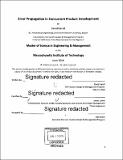Error propagation in concurrent product development
Author(s)
Garufi, David (David J.)
DownloadFull printable version (13.58Mb)
Other Contributors
Massachusetts Institute of Technology. Integrated Design and Management Program.
Advisor
James M. Lyneis.
Terms of use
Metadata
Show full item recordAbstract
System dynamics modelling is used to explore varying levels of concurrency in a typical design-build-produce project introducing a new product. Faster product life-cycles and demanding schedules have introduced the importance of beginning downstream work (build/manufacturing) while upstream work (design) is incomplete. Conceivably, this project concurrency improves project schedule and cost by forcing rework to be discovered and completed earlier in the project life. Depending on the type of project, some design errors may only be discoverable once the build phase has begun its work. Namely, systemic errors and assembly errors that cannot be easily discovered within the design phase. Pushing build activity earlier in the project allows the rework to be discovered earlier in the project, shortening the overall effort required to complete the project. A mathematical simulation, created using Vensim@ system modeling software, was created by James Lyneis to simulate two-phase rework cycles. The model was tuned to match data based on a disguised real project. Various start dates (as a function of project percentage complete) for downstream phases were explored to find optimal levels of concurrency. Project types were varied by exploring three levels of "rework discoverable within the design phase" to cover a range of project types. The simulation found that for virtually all project types, significant schedule and effort benefits can be gained by introducing the downstream phase as early as 30% to 40% into the project progress and ramping downstream effort over an extended period of time.
Description
Thesis: S.M. in Engineering and Management, Massachusetts Institute of Technology, System Design and Management Program, 2018. Cataloged from PDF version of thesis. Includes bibliographical references (page 68).
Date issued
2018Department
Massachusetts Institute of Technology. Engineering and Management Program; Massachusetts Institute of Technology. Integrated Design and Management Program.Publisher
Massachusetts Institute of Technology
Keywords
Engineering and Management Program., Integrated Design and Management Program.